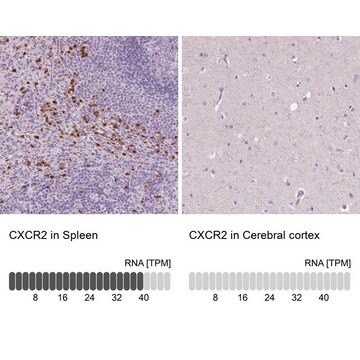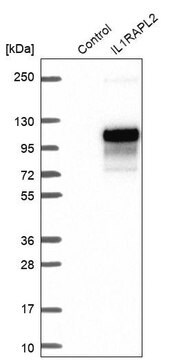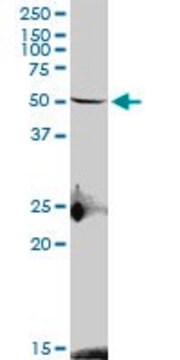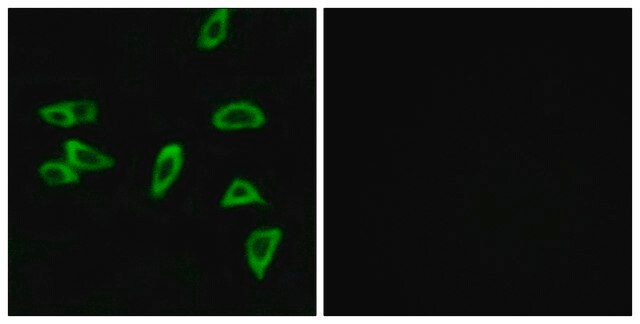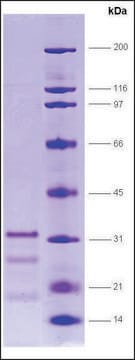HPA010689
Anti-PTGER3 antibody produced in rabbit
Prestige Antibodies® Powered by Atlas Antibodies, affinity isolated antibody, buffered aqueous glycerol solution
别名:
Anti-PGE receptor, EP3 subtype, Anti-PGE2-R, Anti-Prostaglandin E2 receptor EP3 subtype, Anti-Prostanoid EP3 receptor
登录查看公司和协议定价
所有图片(1)
About This Item
推荐产品
生物源
rabbit
品質等級
共軛
unconjugated
抗體表格
affinity isolated antibody
抗體產品種類
primary antibodies
無性繁殖
polyclonal
產品線
Prestige Antibodies® Powered by Atlas Antibodies
形狀
buffered aqueous glycerol solution
物種活性
human
技術
immunohistochemistry: 1:50- 1:200
免疫原序列
MKETRGYGGDAPFCTRLNHSYTGMWAPERSAEARGNLTRPPGSGEDCGSVS
UniProt登錄號
運輸包裝
wet ice
儲存溫度
−20°C
目標翻譯後修改
unmodified
基因資訊
human ... PTGER3(5733)
一般說明
PTGER3 (prostaglandin E receptor 3) gene encodes a seven-transmembrane-spanning protein with multiple C-terminal tails. The gene is mapped to human chromosome 1p31.2 and consists of 10 exons interspaced by nine introns. The TM domain and the 10 amino acid residues of the cytoplasmic tail are encoded by exon1 and 5′ 180-bp portion of exon 2.
免疫原
Prostaglandin E2 receptor EP3 subtype recombinant protein epitope signature tag (PrEST)
應用
Anti-PTGER3 antibody produced in rabbit, a Prestige Antibody, is developed and validated by the Human Protein Atlas (HPA) project . Each antibody is tested by immunohistochemistry against hundreds of normal and disease tissues. These images can be viewed on the Human Protein Atlas (HPA) site by clicking on the Image Gallery link. The antibodies are also tested using immunofluorescence and western blotting. To view these protocols and other useful information about Prestige Antibodies and the HPA, visit sigma.com/prestige.
Applications in which this antibody has been used successfully, and the associated peer-reviewed papers, are given below.
Immunohistochemistry (1 paper)
Immunohistochemistry (1 paper)
生化/生理作用
PTGER3 (prostaglandin E receptor 3) gene encodes a G-protein coupled receptor that functions as a receptor for prostaglandin E2 (PGE2). It induces smooth-muscle contractility. It is moderately expressed in smooth muscle cells of the proximal, mid and distal ureter. It functions via cAMP response elements (CRE) and serves as a target for anti-inflammatory therapy in cutaneous inflammation. This receptor is mainly localized in primary sensory neurons and the spinal cord and functions in endogenous pain control. It has been found to be expressed in the joint nerves of patients with painful osteoarthritis. It plays a role in mediating antinociception during inflammation. It mediates contraction of human intercostal arteries by prostaglandin E2.
特點和優勢
Prestige Antibodies® are highly characterized and extensively validated antibodies with the added benefit of all available characterization data for each target being accessible via the Human Protein Atlas portal linked just below the product name at the top of this page. The uniqueness and low cross-reactivity of the Prestige Antibodies® to other proteins are due to a thorough selection of antigen regions, affinity purification, and stringent selection. Prestige antigen controls are available for every corresponding Prestige Antibody and can be found in the linkage section.
Every Prestige Antibody is tested in the following ways:
Every Prestige Antibody is tested in the following ways:
- IHC tissue array of 44 normal human tissues and 20 of the most common cancer type tissues.
- Protein array of 364 human recombinant protein fragments.
聯結
Corresponding Antigen APREST72461
外觀
Solution in phosphate-buffered saline, pH 7.2, containing 40% glycerol and 0.02% sodium azide
法律資訊
Prestige Antibodies is a registered trademark of Merck KGaA, Darmstadt, Germany
免責聲明
Unless otherwise stated in our catalog or other company documentation accompanying the product(s), our products are intended for research use only and are not to be used for any other purpose, which includes but is not limited to, unauthorized commercial uses, in vitro diagnostic uses, ex vivo or in vivo therapeutic uses or any type of consumption or application to humans or animals.
未找到合适的产品?
试试我们的产品选型工具.
儲存類別代碼
10 - Combustible liquids
水污染物質分類(WGK)
WGK 1
閃點(°F)
Not applicable
閃點(°C)
Not applicable
個人防護裝備
Eyeshields, Gloves, multi-purpose combination respirator cartridge (US)
Gabriel Natura et al.
Proceedings of the National Academy of Sciences of the United States of America, 110(33), 13648-13653 (2013-08-02)
The pain mediator prostaglandin E2 (PGE2) sensitizes nociceptive pathways through EP2 and EP4 receptors, which are coupled to Gs proteins and increase cAMP. However, PGE2 also activates EP3 receptors, and the major signaling pathway of the EP3 receptor splice variants
Dan Longrois et al.
European journal of pharmacology, 681(1-3), 55-59 (2012-02-22)
Arterial vascularization of the spinal cord may be mechanically or functionally altered during thoraco-abdominal surgery/intravascular procedures. Increased arterial pressure has been shown to restore spinal perfusion and function probably by increasing the blood flow through the intercostal arteries. The regulation
M Kotani et al.
Genomics, 40(3), 425-434 (1997-03-15)
Prostaglandin EP3 receptor subtype is a seven-membrane-spanning protein with multiple C-terminal tails generated by alternative mRNA splicing. We report here the structural organization of the human EP3 gene (PTGER3). The human EP3 gene spanned more than 80 kb and was
Matthias Oll et al.
BMC urology, 12, 35-35 (2012-12-12)
Prostaglandins play an important role in ureteral obstruction, but the detailed expression profiles of the prostaglandin receptors (PTGER1, PTGER2, PTGER3, PTGER4, PTGFR) remain unknown in the different parts of the human ureter. The expression pattern of PTGER1, PTGER2, PTGER3, PTGER4
Amrita Ahluwalia et al.
American journal of physiology. Gastrointestinal and liver physiology, 307(6), G602-G610 (2014-07-26)
Clinical studies indicate that prostaglandins of E class (PGEs) may promote healing of tissue injury e.g., gastroduodenal and dermal ulcers. However, the precise roles of PGEs, their E-prostanoid (EP) receptors, signaling pathways including cAMP and cAMP response element-binding protein (CREB)
我们的科学家团队拥有各种研究领域经验,包括生命科学、材料科学、化学合成、色谱、分析及许多其他领域.
联系技术服务部门